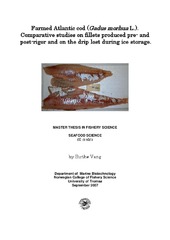| dc.description.abstract | Atlantic cod (Gadus morhua L.) is a promising and relatively new species in Norwegian fish farming. Benefits of cod farming includes stable deliveries of fresh cod all year round, and that the supply of a growing marked can be met without depletion of the cod stocks. Improved slaughter procedures by live chilling and reduction of ante mortem stress, give the opportunity to process the fish pre-rigor, usually within 4 hours pm. Such processing not only reduces fillet gaping which often is a serious problem in well-fed cod fishes filleted post-rigor, but may also lower the transportation costs and make the fresh fillets available to the markets at an earlier stage. Little is known about how pre-rigor filleting affects the drip loss of cod fillets, but the low WHC reported for cod might suggest that it is more severe than in salmon.
The aims of this thesis were to determine weight and length changes during ice storage of farmed Atlantic cod fillets produced pre- and post-rigor. In addition, biochemical characteristic such as pH, water content and water holding capacity (WHC) of the fillets were determined. The concentrations of proteins, gelatine degrading enzymes and cathepsin D in the muscle and drip losses during storage were also investigated.
The results showed that pre-rigor filleting of farmed Atlantic cod resulted in a 10 % weight loss during an 11 day long storage period after slaughter. This loss was twice the amount found in cod filleted post-rigor (5 days post mortem). Such a large weight loss may indicate that pre-rigor production of skinless fillets from farmed cod is not a feasible practice for the industry. The rigor contraction of the pre-rigor produced fillet resulted in a shortening of 27 % on the second day post mortem. At the end of the storage the shortening of the fillets were approximately 19 % while the post-rigor produced fillets merely had contracted 4 %. The shapes of the pre- and post-rigor produced fillets were quite different.
Both the myofibrillar and sarcoplasmatic proteins were apparently very stable during ice storage. However, more sensitive methods than general proteinstaining are necessary to obtain detailed knowledge on post-mortem changes of these proteins in the muscles. The proteins present in the drip losses were very similar to the sarcoplamatic proteins extracted from the muscles. However, some degradation could be detected to have occurred in the drips. Both cathepsin D and gelatine degrading enzymes were detected in the drip losses. As with the sarcoplasmatic proteins, these enzyme activities appeared to be less stable in the drips than in the muscles. | en |


 English
English norsk
norsk